Minimap Importance: Key Roles, Benefits, and Game Design Insights
Updated On: October 26, 2025 by Aaron Connolly
Minimap Importance in Gameplay
The minimap pretty much acts as your sidekick in competitive gaming. It gives you crucial info that directly shapes your performance and every call you make.
Instead of just tossing you a bunch of raw data, the minimap pulls it all together and hands you insights you can actually use. You end up navigating tricky environments and staying one step ahead of your enemies.
Situational Awareness and Decision-Making
With the minimap, you get a bird’s-eye view of the whole game world in a split second. That overview lets you track where enemies are, keep tabs on your teammates, and spot threats before they get out of hand.
In fast-paced titles like League of Legends or Dota 2, glancing at your minimap every few seconds honestly might save your life. You’ll catch enemy rotations, sniff out gank chances, and set up team fights way more smoothly.
Key information you’ll spot on the minimap:
- Enemy hero locations and movement patterns
- Where your teammates are and their health
- Timers for objectives and contested zones
- Safe escape routes for sticky situations
Pro players spend about 20-30% of their time just peeking at the minimap. That habit lets them make informed decisions about when to fight, bail out, or back up their team.
You can also see who controls which parts of the map. That makes it easier to plan your next move and avoid wandering into enemy ambushes.
Navigation and Orientation
Once you really get the hang of reading the minimap, moving around gets a lot simpler. The minimap shows exactly where you are compared to objectives, teammates, and all the landmarks that matter.
In open-world and battle royale games, the minimap keeps you from getting hopelessly lost. You’ll see elevation, building layouts, and routes that help you rotate faster.
Some navigation features you’ll find:
- Waypoint markers to track objectives
- Terrain icons showing elevation and obstacles
- Zones that affect your movement speed or restrict access
- Resource spots and interactive objects
You’ll start picking up on map flow and timing, too. The minimap lets you measure distance, figure out how long rotations will take, and get into position for the next big fight.
A lot of games color-code areas on the minimap—your team’s turf, neutral ground, enemy territory. That visual touch makes quick navigation calls a lot easier when things get hectic.
Enhancing Player Performance
Using the minimap well can seriously boost your game. It keeps you from getting tunnel vision and helps you stay aware of what’s happening everywhere, not just right in front of you.
If you use it right, you’ll position better, die less, and pull off more coordinated plays. You’ll start making moves before the enemy does, which can be a huge deal.
Performance perks include:
- Fewer deaths from surprise attacks
- Better timing on contesting objectives
- Smoother team coordination and calls
- Faster decisions when the pressure’s on
You can even use the minimap to track how you’re improving. Watching replays, you’ll see if you check it enough or miss key moments where a quick glance could’ve changed the outcome.
Players who skip the minimap usually struggle with game sense and positioning. The ones who master it? They climb the ranks with smarter, sharper choices every match.
Fundamental Functions of a Minimap
A minimap gives you instant awareness of the playfield, tracks key locations, and shows where players and objectives are in real time. These features work together to deliver the tactical information you need to make snap decisions.
Playfield Overview
The minimap shrinks the whole game world down to a corner of your screen. You get a simple layout of terrain, walls, and landmarks—no need for fancy graphics here.
You can spot unexplored areas and figure out how different zones connect. That makes planning routes and avoiding getting lost a lot easier.
You’ll usually see:
- Basic terrain and obstacles
- Impassable spots like cliffs or water
- Main pathways and chokepoints
- Boundaries in battle royale games
The minimap updates as you move, so you always know where you are—even when you’re focused on the action.
Map coordinates show up as grids or sector names, letting team members call out exact spots fast.
Tracking Points of Interest
Minimaps highlight the stuff that matters most for gameplay and strategy. What’s important changes from game to game, but it’s always worth checking.
Resource spots pop up as unique icons or colored patches. In strategy games, you’ll see minerals or control points. Battle royales mark weapon drops and supply crates.
Points of interest often include:
- Objective markers (flags, bombs, extraction points)
- Power-up and weapon spawn spots
- Strategic areas like high ground or cover
- Hazards or safe zones
The minimap helps you decide where to head next. You can spot contested zones or find sneaky routes to objectives.
Games use colors or symbols to show who controls what. Red for enemies, green for allies—pretty straightforward.
Displaying Player and Objectives
The minimap tracks where everyone is using different icons or dots. You’ll see yourself as a unique marker, usually with an arrow for your facing direction.
Teammates show up as blue or green dots. That way, you won’t accidentally shoot your own squad in the chaos.
Enemies pop up when a teammate spots them or you use some vision tool. Knowing where they are lets you plan ambushes or dodge trouble.
Player info might include:
- Health bars for teammates
- Role or class icons
- Which way everyone’s moving
Objectives get special markers to stand out—sometimes pulsing or flashing if you’re running out of time.
The minimap keeps all this info updated constantly, giving you a level of awareness you just can’t get from your normal view.
Enhancing Navigation and Map Awareness
Minimaps completely change how we move through virtual worlds. They give us location data and route info instantly, so we can make decisions on the fly and avoid getting lost.
Quick Route Planning
The minimap is your go-to for plotting efficient paths through any environment. You can see where you’re headed, spot obstacles, and pick the fastest route—no need to stop and open a big map.
Most minimaps use colors for different terrain. Roads are white or yellow, water is blue, and mountains or blocked spots are darker.
You save time by just glancing at the minimap instead of pausing to figure out where you are. That keeps you moving toward your goal and aware of your surroundings.
Route planning perks:
- Spotting shortcuts or alternate paths
- Dodging dangerous red-marked areas
- Finding waypoints and checkpoints
- Planning multi-stop trips quickly
Avoiding Disorientation
Big game worlds can be confusing, but the minimap has your back. It shows your exact spot and which way you’re facing.
A directional arrow or triangle makes it clear which way you’re headed. If you’re off course, you can correct it fast.
Landmarks show up as icons, so you start to recognize important buildings, NPCs, or quest spots at a glance.
Features that keep you oriented:
- North marker to show which way is up
- Zoom options for more or less detail
- Trail markers showing where you’ve been
- Warnings when you’re near map edges or restricted zones
Real-Time Updates
Modern minimaps update as the game changes around you. If enemies move, new objectives pop up, or hazards appear, you’ll see it right away.
You get live info about teammates—where they are, their health, their class, and even if their special abilities are ready.
Stuff like storms, day/night cycles, or moving platforms show up instantly. That real-time data lets you adjust your strategy without missing a beat.
The minimap also tracks your progress. Quest markers update as you finish objectives, resources disappear when used, and shops light up when you need supplies.
Some real-time updates you’ll notice:
- Tracking player and NPC movement
- Weather and environment changes
- Objective progress
- Resource notifications
Minimap in Different Game Genres
Different genres use minimaps in their own ways, depending on what players need. Strategy games lean on them for tactical awareness, while MMORPGs make them all about getting around massive worlds.
Strategy and MOBA Games
Strategy and MOBA games really depend on minimaps for tactical advantage. You’ll usually find these minimaps in the bottom-left corner—kind of a tradition at this point.
In MOBAs like League of Legends, the minimap shows:
- All five teammates and their spots
- Enemy locations (when visible)
- Jungle monsters and key objectives
- Tower and base status
Strategy games add even more detail:
| Information Type | Purpose |
|---|---|
| Unit positions | Track army movements |
| Resource locations | Plan economic strategies |
| Unexplored areas | Show fog of war |
| Enemy territories | Identify threats |
The minimap usually covers the whole game world, so you can make strategic decisions without missing a beat.
If you ignore the minimap in a MOBA for more than 10 seconds, you’re honestly asking for a surprise attack.
Strategy players often click straight on the minimap to move units or shift the camera. That makes the minimap feel like a tool, not just a display.
MMORPG Applications
MMORPGs use minimaps mainly for getting around sprawling maps. You’ll usually see them in the top-right corner of your screen.
MMORPG minimaps focus on exploration and keeping you on track:
- Quest markers and objectives
- NPCs and vendors
- Dungeon entrances
- Group and guild member locations
These minimaps are often circular, kind of like a compass, which fits the whole exploration vibe. Most games add North, South, East, and West around the edge.
Handy MMORPG minimap features:
- Zoom controls for more or less detail
- Waypoint setting by clicking spots
- Icon filters to cut down on clutter
- Zone boundaries to show area changes
You can usually swap between a local minimap and a big world map. The minimap is for quick glances, while the full map is for planning.
A quick tip: Most MMORPGs let you resize the minimap. Play around with it until it feels right for your setup.
Role-Playing and Action Games
Role-playing and action games use minimaps for quick awareness. These games often stick the minimap on the left side for easy reference.
Action RPGs keep the minimap zoomed in, so you only see the nearby area. That way, you don’t get overloaded with info when things get intense.
What you’ll usually find on action game minimaps:
- Your position (centered)
- Nearby enemies and allies
- Health packs and ammo
- Exits and save points
First-person shooters blend the minimap with the HUD. You might see where teammates are, objectives, and sometimes enemy pings.
Racing games use minimaps to show the track and where your rivals are. These are usually simple outlines that let you plan your next turn.
A lot of action games change what the minimap shows depending on what you’re doing. During fights, it might highlight enemies, but when you’re exploring, you’ll see more navigation info.
Single-player RPGs often add fast-travel points to the minimap. Clicking these lets you teleport between places you’ve already found—makes getting around a breeze.
Minimap Features and Interactions

Modern minimaps let you control how information pops up on your screen. You get interactive features like zoom controls, communication systems for your team, and navigation tools for exploring bigger game worlds.
Zoom and Scaling Options
Most games let you tweak the minimap zoom with a few simple keys or your mouse wheel. If you want more detail, you zoom in. If you need the whole battlefield, you zoom out.
Standard zoom controls:
- Mouse wheel up/down for quick scaling
- Keyboard shortcuts (often + and -)
- Preset zooms for different situations
Zooming helps a ton in strategy games like StarCraft 2. When you need to check on local units, just zoom in. Planning a big attack? Zoom out and get the lay of the land.
Some games even adjust minimap scaling automatically. During a fight, the map zooms in so you can spot enemies nearby. When you’re wandering, it zooms out to help you navigate.
Pings and Alerts
Minimap pings have become a must for team games. You just click or right-click spots on the map to send quick visual and audio pings to your teammates.
Common ping types:
- Danger pings – Red arrows for enemies
- Assistance pings – Blue for help requests
- Movement pings – Green for routes
These alerts show up on both your main screen and the minimap. Most games limit how often you can ping—usually 3-5 times a minute—to keep things sane.
Pro teams rely on standardized pings in tournaments. A fast danger ping can warn teammates about ambushes or remind them of important map objectives.
Mouse Drag and Movement
You can interact with most minimaps directly using mouse controls. Click and drag pans your camera over different map areas.
Right-clicking on the minimap usually sends your character or units to that spot. It’s way faster than scrolling across huge maps.
Interactive minimap controls:
- Left-click to center your camera
- Right-click to move
- Drag to pan the camera smoothly
- Hover for tooltips about map elements
Strategy games really shine with these mouse interactions. You can select units on your main screen and right-click destinations on the minimap, all without losing track of the action.
Visual Design and User Interface Integration
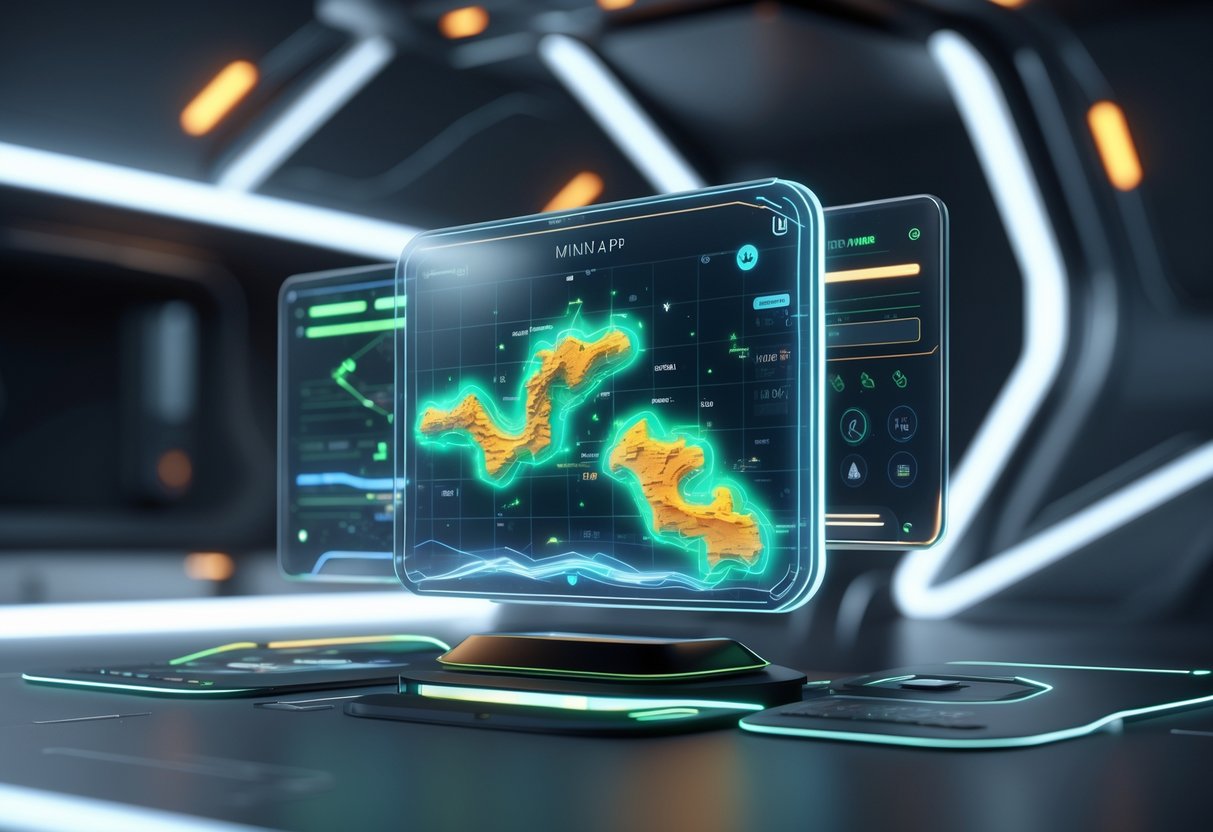
A good minimap needs to be clear but not distracting. Its shape, color palette, and transparency all work together so it fits right into the game’s interface.
Shape and Style Choices
The shape of a minimap affects how you process spatial information while playing. Circular minimaps are the go-to in popular games like Assassin’s Creed IV: Black Flag and Guild Wars 2.
Circles draw your eye naturally and don’t have those harsh corners. They also blend better with modern UI designs.
Rectangular minimaps work especially well for strategy games. Games like StarCraft use squares to match their grid-based maps.
Diamond and hexagonal shapes? They’re less common but add a unique vibe. Fantasy RPGs love these for a touch of mystique.
The minimap’s border style should match the game’s HUD. Thin borders look clean, while fancy frames fit historical or fantasy games.
Colour Schemes and Iconography
Great minimaps use colour schemes that focus on contrast and readability. Players need to spot key info in a split second.
Backgrounds usually stay neutral—dark greys or muted earth tones. This way, the minimap doesn’t fight for your attention. Bright backgrounds just hurt your eyes and drown out icons.
Player markers are typically white, yellow, or cyan. These pop against most backgrounds. Enemies? Red, of course—it’s a gaming standard.
Terrain features get their own colors: blue for water, green for forests, yellow or white for roads. Keeping these consistent with real life helps you get your bearings.
Icons should be easy to recognize at a glance. Simple shapes beat fancy artwork every time. Triangles for direction, circles for points of interest, squares for buildings—keep it simple.
Transparency and Readability
Transparency can make or break a minimap. Most games settle on 70-85% opacity, so you can still see what’s behind the map a little.
If the minimap is totally opaque, it feels heavy and blocks too much of your view. Players often complain about this, especially on small screens.
Some games use dynamic transparency—the minimap fades during combat or cutscenes, then comes back when you’re exploring. That way, it never gets in the way of the action.
Text readability is all about font size and contrast. Location names and distance markers need to stay readable, even on tiny minimaps and high-res screens.
Backgrounds should use subtle gradients or textures instead of flat colors. This adds some depth and keeps icons visible. The goal? Make the minimap feel like part of the world, not just a pasted-on overlay.
Genre-Specific Minimap Placement
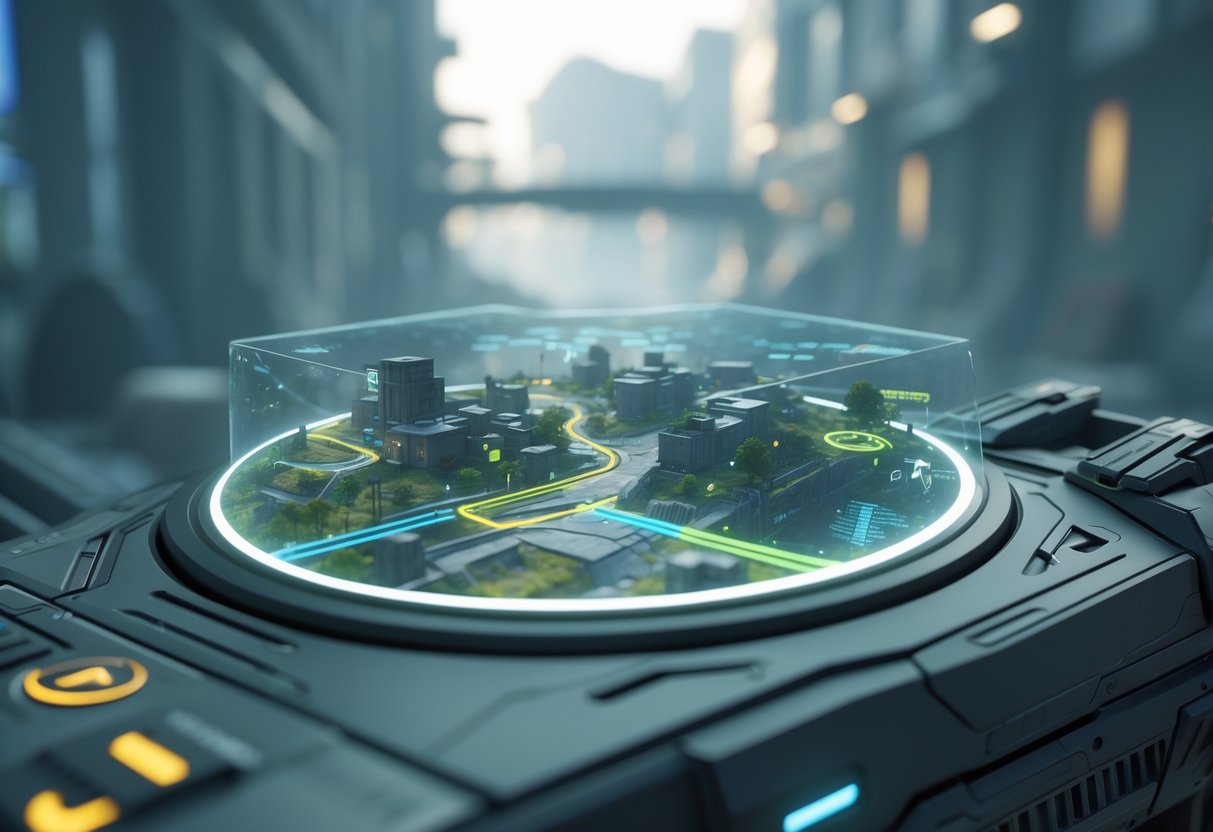
Different genres have their own habits for minimap placement. Fast-paced competitive games usually put it on the left for quicker glances, while strategy games stick it in a bottom corner for easy mouse access.
Conventions in UI Layout
MOBA games like League of Legends and Dota 2 always put the minimap at the bottom. The action stays in the middle, so you can check team positions fast.
First-person shooters almost always use the left side. Call of Duty and Counter-Strike do this because it’s easier to spot enemies when you scan from left to right.
MMORPGs love the top right. World of Warcraft puts the minimap there since players spend a lot of time reading quests and inventory on the left.
Racing games? Left corner, every time. Formula 1 and Gran Turismo place track maps there so drivers can peek at upcoming turns without losing focus.
Strategy games like Age of Empires and StarCraft go for bottom-left corners. Players constantly jump between the minimap and the main battlefield, so this spot just makes sense.
Placement Impact on Performance
Players react faster when the minimap sits on the left side of the HUD. Western players, in particular, scan left to right, so left-side minimaps get checked 15-20% faster during hectic moments.
Miss-clicks become a problem when minimaps sit too close to other HUD elements. If health bars or inventory buttons crowd the map, you’ll probably click the wrong thing in the heat of battle.
Peripheral vision works best when the minimap stays within about 30 degrees of the main action. If it’s too far off in a corner, you have to move your whole focus, which breaks immersion and slows you down.
Sticking with consistent minimap placement gives a real competitive edge. Pro players develop muscle memory for certain spots, and moving the map between game updates can actually mess with their performance.
Types of Minimap Displays
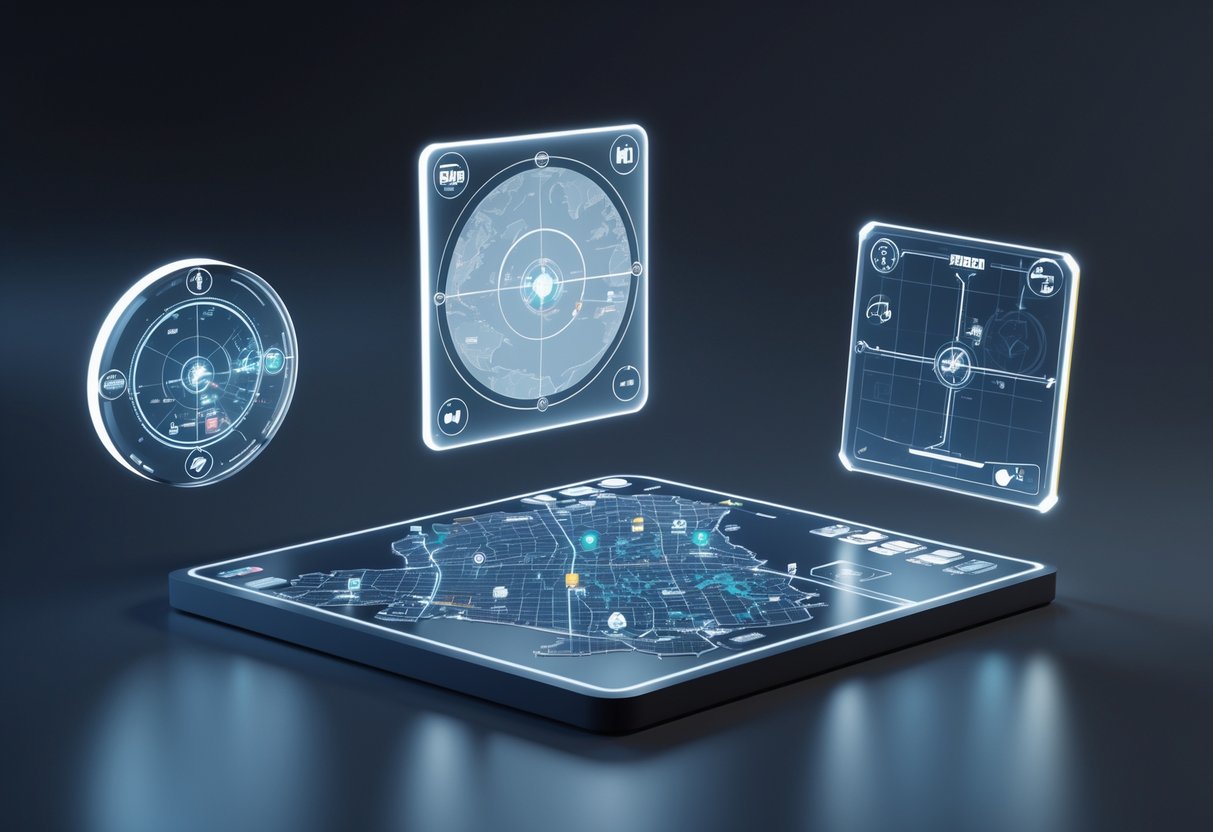
Developers pick different minimap styles to fit their games and help players find their way. Choosing between static or dynamic maps, player-centered views, or world-based maps changes how well you can track objectives and stay aware during matches.
Static Map Versus Dynamic Map
Static maps show the whole playfield and never rotate or move. You see these in most strategy games and MOBAs like League of Legends.
The map always stays put, no matter which way your character faces. This helps you learn the layout and call out directions to teammates.
Dynamic maps move and rotate based on your character’s position and which way you’re facing. First-person shooters use this a lot.
The minimap always keeps “forward” pointing up. It feels more natural but can throw off new players when things get hectic.
| Map Type | Best For | Advantages | Disadvantages |
|---|---|---|---|
| Static | Strategy, MOBA | Consistent reference points | Less intuitive movement |
| Dynamic | FPS, Action | Natural orientation | Can cause confusion |
A lot of competitive games let you switch between these in the settings.
Player-Centred View
Player-centered minimaps show only the area around you, not the whole world. This works best for action games and battle royales.
You see enemies, items, and objectives within a certain radius. That way, you can make quick decisions without getting overwhelmed.
Peripheral arrows pop up at the edges when something important sits outside your view. They point you in the right direction.
Zoom level controls how much detail you get. Closer zooms give more precision but less context.
World-Based Map Scope
World-based minimaps show the entire playfield at once. Strategy games and racing titles use this style a lot.
You get to see every player, objective, and key location all at once. This helps with big-picture planning and team coordination.
It’s easier to spot where help is needed because everyone can reference the same full map. You can quickly pick out weak spots or objectives.
Camera rectangles on the minimap show what part of the world each player is currently viewing. In strategy games, you can click and drag this rectangle to jump your view.
The downside? Showing everything means icons are smaller and sometimes harder to pick out when things get busy.
Racing games often put these full-world minimaps at the bottom, just like the GPS systems drivers are used to.
Accessibility and Customisation
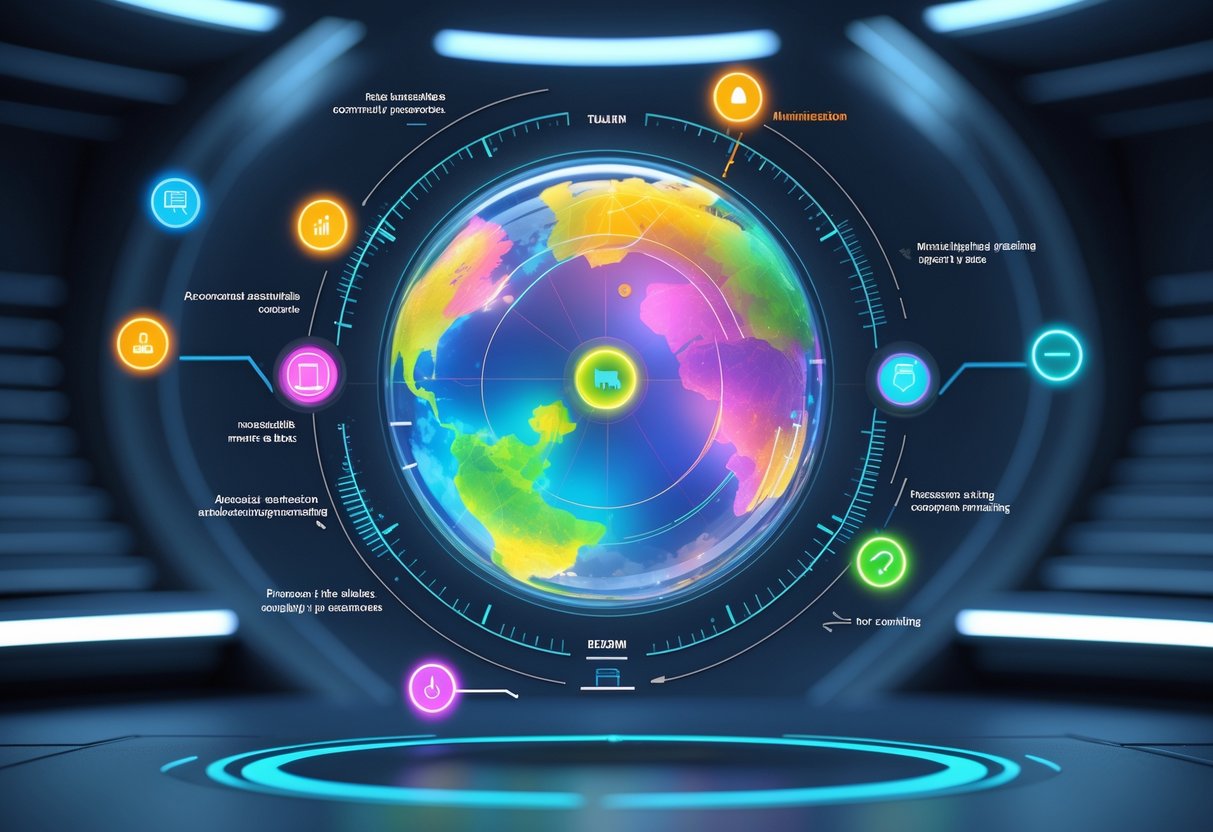
A good minimap works for everyone, no matter their abilities or preferences. Customization lets players adjust the minimap to fit their needs and setups.
Adjustable Size and Position
The minimap needs to be flexible in size and position to suit different players and screens. Some folks struggle with the default spot or size.
Size Options Matter Most
Games should offer at least three size settings: small, medium, and large. Players with vision problems often need a bigger minimap. Competitive players might shrink it down to get more space for the main view.
Position Flexibility
Corner options let players put the minimap wherever feels right. Left-handed players sometimes move it to the top-left instead of the usual top-right.
Transparency Controls
Adjustable opacity helps you balance minimap visibility with your main game view. Semi-transparent minimaps are especially handy during intense moments.
Personalised Settings for Players
Players have wildly different preferences, so personalisation options really open up the minimap for everyone.
These settings should save themselves automatically and stick around between sessions.
Colour Customisation
Letting players pick custom colours helps those with colour blindness tell map elements apart.
High contrast choices make things more visible for anyone with visual impairments.
Icon and Symbol Choices
You’ll find different icon sets cater to all sorts of visual preferences and accessibility needs.
Clear, bold symbols beat out detailed graphics for most folks.
Information Density Controls
Players can toggle which elements show up on their minimap.
Some just want the basics, while others need all the data they can get.
Quick Reset Options
Simple preset buttons let you swap between minimap setups for different modes or situations.
Minimap Challenges and Limitations
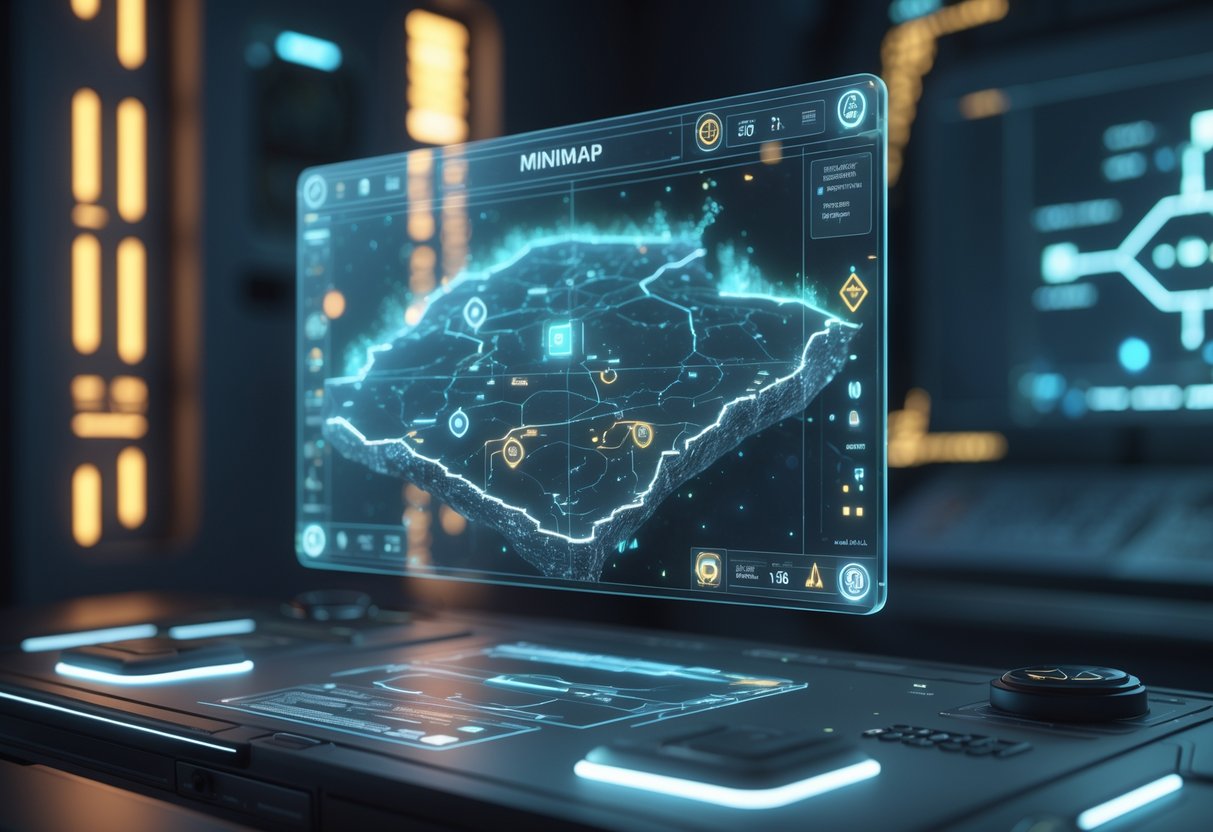
Minimaps hit a couple of major design snags that really matter.
If you cram in too much info, you get visual chaos.
Too little, and players feel lost.
Visual Clutter and Overload
A crowded minimap turns useless faster than you’d expect.
When developers stuff in too many arrows, enemy markers, and objectives, players just stop looking.
Most games fumble with information hierarchy.
Red arrows fight blue dots, yellow markers clash with green zones—your eyes just can’t keep up when things get hectic.
Performance can tank, too.
If a game tries to render dozens of icons every frame, older machines start to drop frames.
Some titles update minimap info every single frame, adding extra processing for no good reason.
The worst minimaps just dump everything at once.
Quest markers, teammates, enemies, resources—all jammed into a tiny box.
Players often feel swamped and end up ignoring the minimap entirely.
Smart developers add toggle options.
Players pick what info they want based on what they’re doing.
Combat mode might just show enemies and allies, while exploration mode brings up resources and quests.
Balancing Detail and Simplicity
Finding that sweet spot between helpful and overwhelming? Not easy.
Too much detail and icons blur together, but oversimplifying kills the minimap’s main value.
Icon size always causes headaches.
Bigger icons are easy to see but hog space.
Small ones save room but vanish in the action.
Colour coding helps, up to a point.
Most games stick to red for enemies, blue for allies, yellow for objectives.
If you mess with these, players get confused.
Some devs fix this with layered info.
You see basic icons by default, then get more detail by hovering or pressing a button.
It keeps things tidy, but you can dig deeper if you want.
Modern minimaps usually let you zoom.
You can zoom out for strategy or zoom in to navigate tight spots.
This flexibility works for all sorts of play styles without cluttering the main view.
Best Practices for Effective Minimap Usage
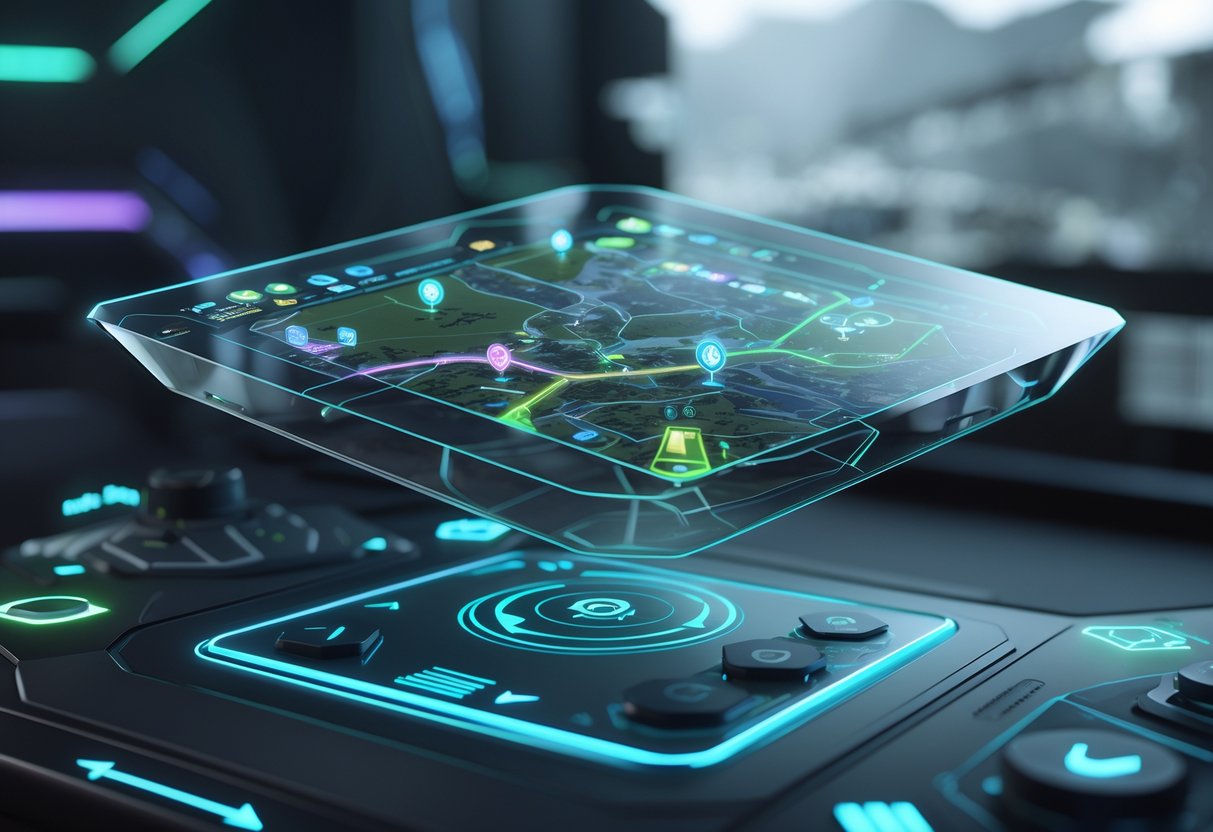
Building solid minimap habits takes practice and some clever communication.
Both can totally change how you gather info and make smart choices during tense moments.
Frequent Reference Habits
The trick to using the minimap well? Build up a habit of checking it automatically.
Most pros glance at their minimap every few seconds.
Try checking the minimap during natural pauses—like when you reload, rotate, or just hold an angle with no action.
Practice this timing:
- Right after a kill or death
- Before peeking a new angle
- During ability cooldowns
- While moving between spots
Visual anchors help, too.
Some players use their crosshair placement as a reminder—every time they adjust, they sneak a quick peek at the minimap.
The minimap gives you context for your choices.
If your teammates bunch up on one site, you’ll know where you’re needed.
Quick tip: Don’t stare at it for more than half a second.
Short glances keep you aware of threats and still let you gather vital team info.
Strategic Information Sharing
Turn what you see on the minimap into clear callouts.
Use the real location names from your minimap, not vague stuff.
Call out enemy spots using the minimap: “Two pushing A main” beats “enemies over there” every time.
Key callouts:
- Enemy spots from abilities
- Flanks behind teammates
- Rotations and player numbers
- Spike location changes
Point out gaps in team coverage.
If everyone’s focused on one spot, say which sites need help.
Use minimap info to guide rotations.
When teammate icons vanish in certain areas, call for backup or suggest repositioning.
Track big ultimates like Viper’s Pit or Killjoy’s Lockdown with the minimap.
Those zones are obvious—let your team know when to avoid or exploit them.
Frequently Asked Questions

People have plenty of questions about minimaps—how they work, why they matter, and what makes them tick.
Most of the time, it’s about navigation perks, user experience boosts, and what goes into making them actually useful.
Why is having a minimap considered crucial in navigation-based applications?
Minimaps give you instant spatial awareness.
You don’t have to open a big map and lose time.
In games, minimaps show where you are compared to objectives and other players.
You can make quick decisions about routes and strategy without taking your eyes off the action.
Apps like Google Maps use minimaps to show your spot in a bigger area.
That helps you figure out where you are in relation to landmarks.
Minimaps update in real time as you move.
You stay on track and avoid wrong turns.
How does a minimap enhance user experience in games and software?
Minimaps cut down on the mental work of remembering locations.
Just glance at the corner of your screen—no need to memorise big layouts.
You get a bird’s-eye view of stuff that’s hidden in the main display.
Enemies, teammates, and objectives all show up at a glance.
Customisation lets you tweak minimap size and transparency.
Many games let you turn info layers on or off.
Quick peeks mean you don’t have to pause or stop.
The whole experience feels smoother and less interrupted.
What are the advantages of including a minimap in an interactive platform?
Minimaps speed up decision-making by packing key info into a small space.
You can judge situations and plan your next move faster.
Strategic play gets a boost from the tactical overview minimaps provide.
Team coordination improves when everyone can see positions and movements.
Keeping the main interface clean is easier.
The minimap doesn’t hog space but still gives you what you need.
New users have it easier, too.
Visual cues help them get around without memorising everything.
In what ways can a minimap contribute to efficient orientation and movement within a digital environment?
Minimaps always show where you are in the bigger picture.
You won’t get lost in complex virtual spaces.
See terrain features, paths, and shortcuts at a glance.
You can plan better routes without wandering everywhere.
Objective markers point you right to your goals.
Important spots stay visible even if they’re not on your main screen.
Movement gets more purposeful.
You waste less time backtracking or running in circles.
How does the design of a minimap affect its usefulness and user interface?
Getting the size right is crucial.
Too small, and you can’t see details.
Too big, and it blocks what matters.
Colour coding helps you spot different info quickly.
Enemies might be red, friendlies blue or green.
How often the minimap updates also matters.
Frequent refreshes keep your info accurate.
Good contrast and clear icons make the minimap easy to read.
If things get muddy or cluttered, the minimap stops being helpful.
What are some key features that make a minimap user-friendly and informative?
You need clear player position indicators. They show exactly where you are and which direction you’re facing.
This kind of orientation info really helps. It keeps you from getting confused about movement controls.
Zoom functionality is a big deal too. You can check out detailed local areas or get a broader overview, depending on what you need at the moment.
Flexible viewing options make navigation so much easier. Sometimes you just want to see more, or less, of the map.
Information filtering is another must-have. Users decide what appears on their minimap, which means you can hide stuff you don’t need and keep things tidy.
Consistent visual language across screens goes a long way. When icons and colours feel familiar, you catch on to minimap symbols without thinking twice.

